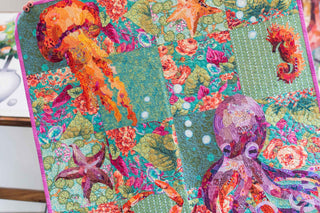This quilt is my new FAVORITE! The unexpected color scheme is so interesting and everything coordinates in a unique way.
The origin of this quilt began with the crab in 2021. Exactly one year ago I was doing a 30-day creative challenge and I developed a series of critters. The crab was one of them! I made a BIG mistake, however, when I adhered the crab to background fabric and then created a block with it before I had even formulated a plan. I eventually put the original crab away to use in a future project and made another one.

The 2021 creative challenge revealed to me how much I enjoy doing intricate oversized creatures, and was also the genesis of the Wee Green Beasties quilt.
I continued playing around with creatures and decided that I'd like to develop a sea creatures quilt. I collaged sea shells (which never ended up in the quilt), the starfish, and then the octopus.
The octopus sat incomplete for several months as I worked out how to execute the underside of his tentacles (the suckers had me absolutely stumped). While I was thinking on that, I got started on the jellyfish.

I couldn't be happier with the way the jellyfish turned out! As with any collage, what makes it so interesting is the fabric selection-- the interplay between light yellow, orange and then warm purple in the shaded areas. What I've learned from this is to try using a color change to represent changes in value. Rather than using a darker orange where there is a darker value in the design, I chose to use purple to indicate a darker area of the design. It works extremely well!

When I finished the jellyfish, I took what I learned and applied that idea to the problem that had been troubling me with the octopus-- only in reverse! The tentacles of the octopus needed to look like they twist around, and therefore needed to have contrast to indicate the top and the underside. And, as I mentioned, I was stumped about how to create suckers. The conundrum about the underside vs. the top side of the arms was solved by using an entirely different color than the main part of the octopus. The main body of the octopus is purple. So my choice for the underside is orange (using the same color scheme as the jellyfish).

The dilemma about the suckers was solved by applying one of my most important rules: "Let the Fabric Do the Work!" I selected fabric that has dots and lots of interesting stuff happening. The fabric provides a subtle suggestion of suckers. This is an important principle-- creating a suggestion of something, rather than getting bogged down in the intricate details.
When I had my collage creatures finished, I began looking for fabric to help me pull the whole thing together. I couldn't have been more pleased with the main print that I selected to use in the quilt (Rose and Hydrangea in green by Kaffe Fassett for Free Spirit). This gorgeous fabric had all the colors I had just used in my creatures on a sea green background! I also loved the whimsical look that was created by adding these interesting sea creatures to a lovely floral print. The title, "Octopus Garden" is a natural fit for the quilt because of this fabric.

This quilt was quilted by Marion McClellan. I love sending my quilts to her because I trust her completely to use her own judgement on the best way to quilt my projects. Marion is an artist in her own right! With this project, she used a variety of threads-- matching thread to the color of each section of the quilt. (See the blog post, "Conversation with a Longarm Quilter" for more information about quilting)


The easiest creature to make? The Seahorse!
The most complex creature to make? The Octopus!
How to make the bubbles look realistic? Inktense ink pencils

I hope this info inspires you to dive in to make your own Octopus Garden quilt! ~Emily



